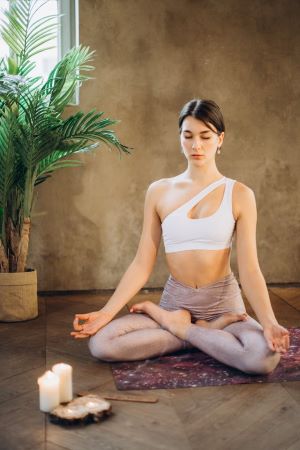What I Learned About Yoga When Injury Forced Me To Stop.

Everyone has fears.
Our phobias are one of the odd occurrences binding us mere mortals together.
Mine just so happens to be getting hurt.
While avoiding injury is a natural inclination (for most of us, anyway), my avoidance of pain is rooted deeper and paves way for a disorder against deep discomfort – specifically when it is out of my control.
Growing up, I could deal with the physical sorrows that came with nominal childhood pursues. The wrenched, broken ballet toes. The rough and tumble and scraps with siblings. It was all in good, clean, prelapsarian fun. No fear, all frolic and frisson.
But once a horse bolted with me floundering in a gravity-defying blur above its saddle, things changed, and the fear became really rather real.

Thrown on to the bonnet of a passing car and suffering a broken, dislocated shoulder and elbow, things changed. And that’s when I found yoga. Partly to facilitate my rehabilitation, partly because it felt safe. I thought it would give me the challenge and physicality that I needed, whilst keeping me in the safety of my own home – and of my own volition.
Twenty-five years on, I was right. Yoga had kept me safe and even paved a route into a side-hustle when I started teaching. But, once that conduit of comfort caused an injury, my perspective of the pursuit of enlightenment completely changed. At the point where my body broke and forced me to stop my practice, here’s exactly what I learned.
My Relationship With My Body Just Wasn’t Working
This is a feeling most of us can relate to. Once my injury suspended the physical portion of my yoga practice, I realised just how fractured my relationship with my body had become. Regimented routines of complex and advanced asana certainly provided continuous challenge and focus points. But they were masking a hidden inner desire to punish and push my body when it might not have been ready – or even wanted to.

Once I was granted the opportunity to step away from these borderline institutionalised practices, I realised how much more valuable it was to use my body in a loving and intelligent way. As a postgrad of anatomy and physiology, I’m naturally curious about the inner workings of our physical forms. But this break gave me even more qualification to uncover and understand the intricacies of how our body functions. And by focusing on a small selection of postures, rather than cramming a thousand into a practice, I calculated how to use my body to comfortably achieve them – and ultimately master things I previously deemed unattainable.
Once you establish respect for your body, you no longer feel the need to keep punishing it.
I’d Been Underestimating The Power Of My Breath
Throughout my career as a yoga practitioner, and even as a teacher, I’ve severely neglected my breath. I’ve made a continuous conscious effort to remedy that, but it isn’t an aspect of yoga that comes easily to me.
But it is a fundamental part of yoga, so, once I stopped committing so much time to seeking perfection in physical practice, I sat down and took a big exhale. And an even bigger inhale. Then another bigger exhale still. There it was. The joy of breathing, for the very first time in my life. Slowly, I began to align it with my asanas.

Flowing from one posture to the next, seemingly in a trance-like state, often left with no recollection of the poses I’d just performed, the power of my breath was found. And it was everything everyone had always said it would be.
It gave me clarity. Focus, drive, determination, and direction. It released stagnant emotions and elicited salty tears that needed to seep through the cracks. It eliminated pain and diluted fear. I’d avoided headstands for twenty-five years (yep, there’s that Algophobia again), but could now at least get into a half iteration.
While I understand the biological effects of increased oxygen intake through proper breathing, nothing could ever truly explain the sensations I experienced when my breath began to punctuate my practice.
I Had To Take Yoga Off My Mat
Our western lives and misconceived notion that yoga glorifies the body means we miss the whole point of yoga: union. If you’re isolating yourself in a practice at home, or practicing in silo at the same studio class, week in, week out, the union can’t happen. But that sense of union doesn’t have to just be for the purpose of an asana practice. It can be out in the local community, supporting a friend or family member through a difficult time, or helping a neighbour. Just being more present and conscious to others and the world around you will evoke the true nature of what it is to live as a true yogi.

And it even made me rethink my career. While I taught yoga at night, my day job had left me unfulfilled since I left university. Working in the fashion industry, people always wanted something from me, they had no interest in getting to know me. I’d been depleted. The opportunity to recognise this was a blessing in disguise and endowed me with the power to change the course of my future, and establish myself in a career that, each day, feels like an act of yoga.
To Have Fun
A fairly driven individual, with chronically perfectionist tendencies, I used to place prize in the fact I could stand in Tree pose for 30 minutes at a time. Even though I felt a smug sense of satisfaction, it was still not enough, and I was always striving to stand on one leg for longer. It wasn’t emblematic of achievement; it was a concealed cachet for self-flagellation.

I wasn’t having fun. From the moment I started yoga, to the point I broke, I could only count a handful of times where my practice felt like fun.
Perhaps it’s age and maturity, but I see things in retrospect and wonder how I let myself show up to my practice like that. Prosaic and stoic, only investing for a result and not focusing on the process and the joy of the movement.
It might feel like I lost years of enjoyment with my practice, but my injury segued for the process to start over. And this time, I didn’t allow old habits to die hard. I tumbled out of headstand, I wobbled in tree, and I let my cats crawl all over me in downward facing dog. Purely for the irony, of course!
In complete candour, the most important thing I learned was just how much more I am than this physical form of mine. Whilst I’d always believed it, I’d never truly accepted it – until I had to.
This revelation instilled in me that, even though it’s not all about the body, the physical component of who I am is protecting and carrying forward everything else that makes up ‘Kate’ – so I need to treat it with more respect. Because I truly wasn’t. I thought that rigorous practices, for hours on end, were honouring my physical health. In a certain sense they were, but from another point of view, they weren’t. I came to realise that forcing my body to do things it didn’t want to do wasn’t conducive to a healthful experience: and just because it’s under the veil of a yoga practice doesn’t mean it’s necessarily what’s best for your body. Or that you’re treating your body with consideration and kindness – which is a prominent point of yoga: non-violence and non-harm. And that starts with exactly how we treat ourselves.
Where introspection is heralded as the key to unlocking intuitive notions of what your body needs, I don’t believe it’s the magic wand we wave to enigmatically irradiate all that is ‘yoga’. Introspection actually just paves an avenue for us to take our first steps on a long journey to learning about ourselves.
The further along we walk, the more we uncover and the more attuned we become to all the layers comprising our existences. Eventually, our heads and hearts separate, and we become witnesses over our lives. By watching over ourselves, we can start to think differently. Part of the evolution of our thoughts is the regard held for our bodies and exactly the part it plays in our existences. For someone like me, terrified of any physical infliction on this fragile physical form, this changing and expanding of how I think about my body completely transforms.

By allowing myself to step outside of my three dimensions and allow my soul to take the drivers seat, my fears evaporated and, for the first time in four decades, I’m free from phobia and allowing my body to carry me forward on my own path in an unabandoned, beautiful yogic dance.
Main – Photo by Miriam Alonso




